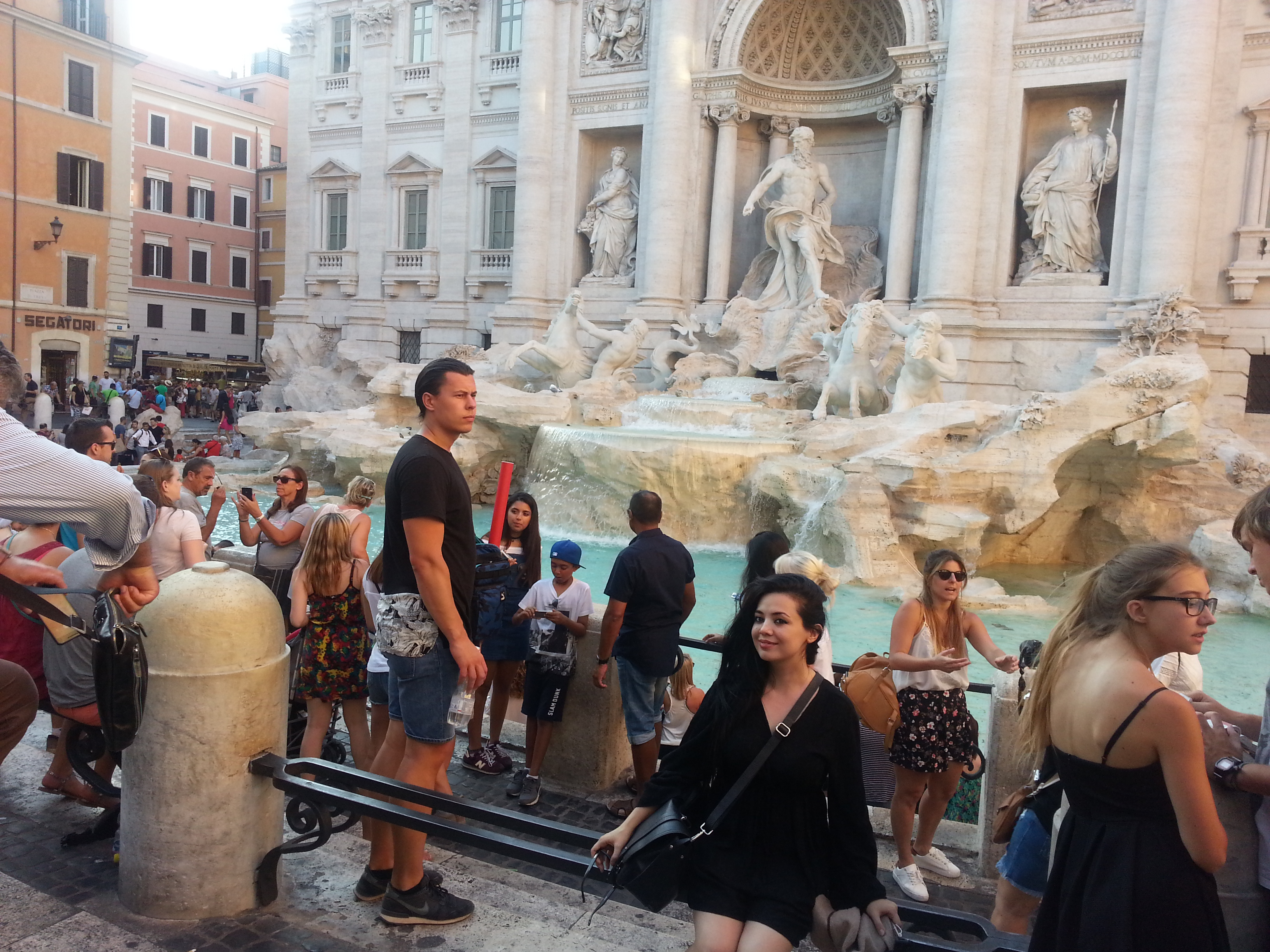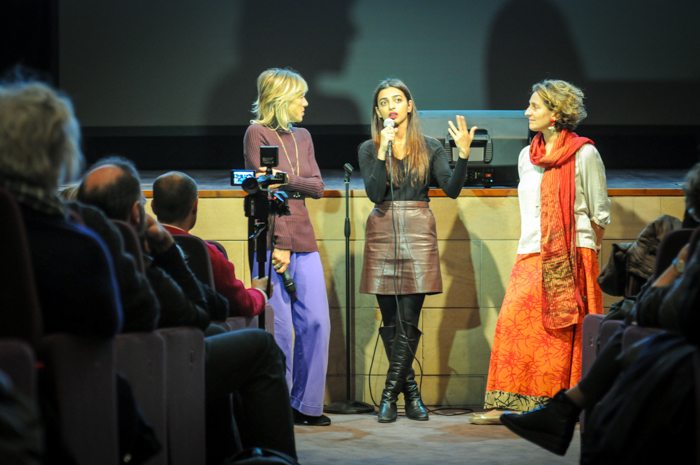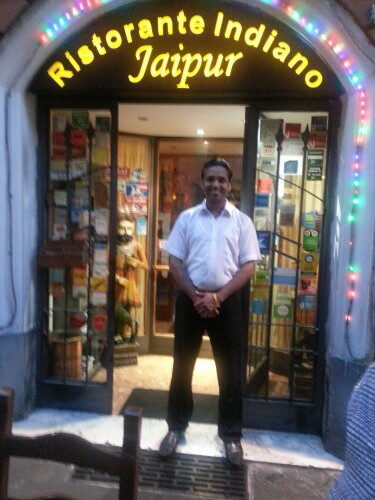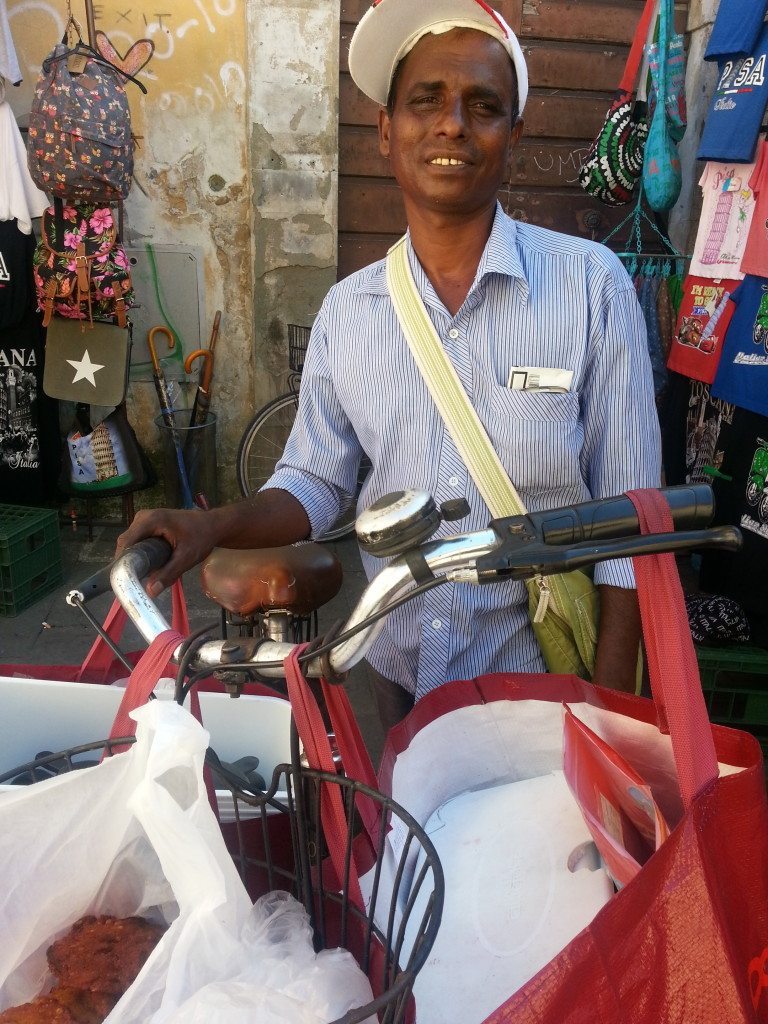2026 people reached on Lassi with Lavina FB page – 219 post clicks
Sonam Saxena, Navdeep Cheema and 62 others like it on Lassi with Lavina FB page
Nninja Singh, Jessy S. Moya and 22 others like it on FB

An Indian in Italy: My Adventures in Rome, Venice & Tuscany…
In these days of the pandemic as the cold days linger and travel still remains an impossible dream, I fly you on the magic carpet of the past to Italy! To Rome, Venice and Tuscany.
Unlike most tourists, I also visit a surprising parallel world far from the radar of travelers. The unknown world of the Indian-Italians, a thriving desi universe in Italy!

[dropcap]H[/dropcap]ave you heard of Lavinio? It is a small seaside town in Italy, about 50 kilometers from Rome. But now it has a new name: Love-India! It is informally called this name by the Italians because of its surprisingly large Indian population. It has thousands of Indian migrants, Indian restaurants and even an Indian grocery store. It is a place of gurudwaras and langar prasad, bhangra and Bollywood. You should not be surprised to see a Nagar Kirtan procession or an authentic kabbadi match in this Italian countryside!
Indeed, if you thought there was just a handful of Indians in Italy, you’ll be surprised to learn – like I was – that, according to the Bureau of Labor statistics, there are well over 150,000 Indians. During my visit I met several Indian-Italians, and corresponded with others via email and Whatsapp.

[dropcap]W[/dropcap]hen I visited Italy, like any avid tourist I checked out many of the must-see spots of this intoxicatingly beautiful country – the magic of Tuscany, its verdant vineyards, its fig and olive trees, its luxurious villas; the shimmering watery poetry of the magnificent floating city of Venice; the rich art treasures of Florence; the fabulous ruins and intricate history of Rome.

[dropcap]B[/dropcap]ut unlike most tourists, I also visited a surprising parallel world far from the radar of travelers. The unknown world of the Indian-Italians, a thriving desi universe in Italy!
I We encountered Indians from Rome to Venice to Sienna. In fact, my most surprising encounter was at the Leaning Tower of Pisa. There in the midst of a tsunami of international tourists stood a wiry gentleman from Chennai, actually selling samosas and kachoris from a tote bag dangling from the handles of his bike! He still had a few kachoris left but was all out of samosas. What is this universal appeal of samosas? I’m sure when we land on Mars, a wiry gentleman on a bike will be ready and waiting, with his ‘mast-mast’ samosas!
[dropcap]S[/dropcap]o as I traveled and enjoyed the cuisine, the wine and the museums of Italy, on a parallel-track, I always had my Indian-antennae up to spot desis in their new habitat and see what they were up to. One thing I realized is that Indians were everywhere though not in large numbers – in the dough, in the ingredients and in the toppings of the Italian pizza! I met Indians from all walks of life- as farmers, as promoters of Italian culture and as tourists visiting the country.
Italy, with its fabulous natural beauty, cuisine and wine, is also emerging as a destination for Indian weddings. There have been Indian weddings which have been held at Florence, Milan, Rome, Positano and Amalfi coasts.
Indeed affluent Indians from the homeland and the Diaspora are involved in an annual summer exodus to Italy as tourists. I did see several Indian tourists, which speaks to India’s increasing wealth and clout in the world. From Florence to Rome to Venice, there were Indian families in hotels and restaurants, enjoying the world. In the Vatican I met Gujaratis and Sindhis from Montreal.
To fully understand the influx of Indians into Italy, I looked into the past. When I left New York for Italy on a summer holiday, the only Italian connection I knew of was that India’s Sonia Gandhi is Italian, and that the road in her native town of Orbassano is called Via Rajiv Gandhi. Orbassano is close to the city of Turin, and her family still lives there. Besides Sonia and Rajiv Gandhi’s children, Priya Vadra and Rahul Gandhi, there are a few other well-known Indian-Italians living in India – Dino Morea, supermodel and actor, and Shiva Keshavan, a five times Olympian and luge champion.

[dropcap]I[/dropcap] also trekked out to the Indian Embassy in Rome to meet with Ambassador Anil Wadhwa ( he has since I wrote this piece finished his tenure in Italy) and get the official account of the Indians in Italy. I have to say our embassy on Via XX Settembre 5 is architecturally stunning. Wadhwa who has been in Rome for just under a year, is very knowledgeable and filled me in on the details on the Indian presence in Italy, starting with the beverage he offered – cappuccino. “No one knows how to make Indian tea here,” he joked.
“Italy is a country with whom India has had very deep commercial and economic ties,” he pointed out. “Between 2007 and 2012, for five long years, Italy was the No. 1 one trade partner of India both in terms of the investments as well as trade. That’s because they were really anxious about starting the Indian story here and we had some very high-level visits at that point in time.”
There had been a crisis with two Italian marines implicated in the killing of Indian fishermen in Indian territorial water in 2012 and that had certainly soured relationships but now with the return of the Marines to Italy to await trial, things have improved. Recently high level ministers from the Modi Government were in Rome for the canonization of Mother Teresa and the occasion was used to restart the relationship.
“We have a roadmap for the future,” said Wadhwa. “The main focus is on the economic side––investments and cutting-edge science and technology, design, and we have traditional areas of cooperation which is in leather, textiles, gems and jewelry. So we want to build on that and basically get back to the old relationship. The embassy has organized about 12 focused commercial events in various Italian cities. We have an ongoing relationship. Currently we are also talking about $ 3 billion in contracts and about joint manufacturing too.”
The Indians in Italy each have their own story about their journey. Rome has over 1500 Indians including dancers, academicians, and yoga teachers and I had conversations with some of them. Sanjukta Das Gupta, who was earlier teaching at Calcutta University in India, moved to Italy when she married an Italian colleague and now teaches at the Department of Oriental Studies at La Sapienza University of Rome. She says there are few academics in Italian universities but she is the first Indian historian in Sapienza.

“The best part of Italy for me is that I live amid so much visible history,” she says. “Almost every road takes you to some site dating back to ancient times. But Rome is not only about the past, but the past blends in with the present. This for me is the greatest fascination of Italy.”
Ask her about the Indians in Italy and she divides them into migrant labour – mainly from Punjab and to be found in the agricultural regions of north and central Italy; Restaurant workers, mainly Punjabi and Keralites. Religious migrants: priests and nuns, again mainly from Kerala; People working in the different UN organisations – the ‘international’ set and nothing to do with migrants; the spouses: Indians married to Italians; and a floating population of students.
She mentions that there are a few academics working in the management schools, in the ecumenical schools, and also some who are in the space-design industry. There are some Indians in the healthcare industry, while others work in churches or are with the Vatican.
[dropcap]A[/dropcap]ccording to statistics, the majority of the Indians are farmers from the Punjab. They are all doing exactly what they did back home – farming with the unique distinction of having added cheese-making to their crafts. They are spread all over – in the north, around Rome, in the Lazio region, and also down south in Naples, Bari and Sicily.

The South Asian presence is quite noticeable since Italy has taken in a large number of refugees. You cannot miss the Bangladeshis selling everything from tourist trinkets to roses on the sidewalks, and there are many Pakistani tour guides. Indians are also a big part of the tourism industry. Be it at the Trevi Fountain or the Vatican, you cannot help noticing the Indians, Bangladeshis and Pakistanis who are vendors of tourist tours and souvenirs.
Viva Italy!
(Photos: Lavina Melwani)
[dropcap]O[/dropcap]ur group of 14 family and friends stayed at Torre del Santos, a beautiful old villa in the village of Barberino Val d’Elsa at the edge of the hamlet of Petrognano, which was about a half hour from the must-see cities of Siena and Florence. The Tuscan countryside is dotted with medieval villages, marketplaces, wineries and restaurants. The very first night I discovered that the Italian owner of the villa had been to India, and her teenage daughter is passionate about India and eating Indian food!
I had connected with some Sikhs from Tuscany and we tried setting up meetings. All of them were really helpful and happy to talk about their journeys. One of them was Balbir Singh Pabla who worked with Italian designers in leather and offered to take us to the designer outlets and get us some great discounts too! Unfortunately with the special itinerary of our gang of 14 – Italian cooking classes, truffle hunting, watercolor classes and visiting vineyards and the Ferrari Museum – we were unable to take him up on the offer. However, I learned a lot about how our Indian migrants function – he had brought his leather-working skills and habits of hard work with him, maintained his culture, family and religion and yet become a part of the Italian municipality and was helping to promote the local area to tourists.

[dropcap]T[/dropcap]hrough our villa owner, I met Balbir Singh Sangha, who is an Italian chef with some of the best t-bone steaks in town! Sangha, who came from Hoshiarpur in the Punjab in 1989, traveled the traditional way through farming because of the language problem. He had gone back home for an arranged marriage to Parmjeet Kaur who is a housewife, and now has grown children in their 20’s. Gradually he got into cooking and for the past 20 years has worked in restaurants in Rome and Tuscany. He now cooks everything Italian – though at home it is always Indian food cooked by his wife. Did people in his village get surprised when he first left for Italy? Singh laughed, “Everyone is leaving for abroad – now our Punjab is getting empty!”
The Hindu presence is there in Italy too, though much less than that of the Sikhs. Vishnu Kumar Soni, who deals in the export of scrap metal to India, is one of the devotees helping to build a Sanatan Dharma Mandir in Lavinio in the province of Anzio. There are already two temples in Rome and there has been a good response to the building of this new temple, he says. “ Hindus from different parts of Italy come together in Lavinio for jagrans, Krishna Janamashmi, Navratri and a weeklong Diwali festival.”

[dropcap]S[/dropcap]oni came many years ago as a tourist, liked it and decided to stay on in Ansio. He went back to India to get married and brought his family to Italy. He says, “Rome is a mini India – all agricultural work is done mostly by Indians – and almost 95 percent of the Indians are in agriculture. The young Italians are not into agriculture or construction – but our people coming here are ready to do any kind of work, and are already comfortable in agricultural activities from India.” As he points out, Lavinio – Love India – is 3 kilometers past the ocean – and has 16 Indian and 11 Pakistani spice stores because there are so many South Asians there!
There are about 52 gurudwaras in Italy, and some local governments have also given land for stadiums to play cricket. There are also cultural festivals where the groups perform on the beaches and some shows from India, like a Kathak performance by danseuse Shovana Narayan attracted a crowd of 1200 in the town square.
Bollywood is also a spicy presence in Italy. While eating in a wayside café or shopping in stores, I was mesmerized to see some kind of a desi ad or programming pop up occasionally on regular Italian TV. One has to remember Kabir Bedi was a big hit here because of ‘Sandokan’ and was honored at the River to River Indian Film Festival in Florence where ‘Mohenjo-Daro’, in which he also stars, premiered.

In fact, it’s hard to believe the River to River Festival is in its 16th year, the passion of Selvaggia Velo, who is the founder of the festival. I was in touch with her and she shared the reason for doing this festival: “Indian films hardly get a release in Italy, and the festival is one of the only places where you get to see such films. It all happened by chance – I liked India and cinema and decided to put the two things together: so with study and dedication, passion, intuition, and many other things now we have just finished our 16th edition!”
Ambassador Wadhwa confirmed that a lot of Bollywood shootings took place in Italy: “There’s a place called Matera which is famous for Biblical films because the houses are inrock caves in the hillsides. It’s a very peculiar kind of setting – the whole town is made of stone, so it’s an ideal place for those kind of films. But many Indian films have also been shot there.”
Bollywood in Italy

[dropcap]A[/dropcap]mbili Abraham, an Indian dancer, has built her career on the Bollywood craze. She runs a dance school in Rome. Her father, who earlier worked in the Indian Embassy in Rome, is from Kerala and her mother is from Mizoram. Abraham picked up dancing when she was five and since the past 16 years runs classes and workshops all over Italy. The majority of her students are Italians but also Indians who have been adopted by Italian families and are in search of their roots. This year she worked with 140 students on a dance campus organized by the Lund Dance Center in Ancona.

[dropcap]H[/dropcap]er Bollymasala Dance Company has taught students who have now graduated to becoming teachers themselves! She has often been on Italian TV and is reputed to be the one who brought Bollywood dance to Italy. She says, “I have been blessed by students who really give me lots of love and respect. Italy is now my second home. My main aim is to make my students love the Indian cinematic world and make Italians understand the power of Indian cinema. After a month of dancing, they may say “I love Shahrukh Khan!” – that does make a difference to me!” In fact, she told me an Indian-Italian couple has opened another Bollywood dance school in Rome now, called Bollywood Club.
There are also many mixed marriages in Italy, with more of Indian women marrying Italian men rather than the other way round. Italian men often come back from India with an Indian wife. Roshni Sekhar came to Italy 30 years ago, after she married her husband Paol Quircio, who was then working for Alitalia in Delhi The couple have two children Maitreya and Flaminia Bhavani, and have devoted themselves to propagating yoga in Italy. Roshni, who is a direct disciple of Swami Vishnu Devanda, noted follower of Swami Sivananda. She runs the Centro Yoga Swami Vishnu and has also taught Hatha Yoga for the Sivananda Teachers Training course in Italy.
She says, “We spread peace through yoga and we take demonstrations, theory classes and practice classes to the high schools, to give a correct overall view of yoga to the young. Also, every year, through various cultural activities by raising funds, we support animal organizations in India and help in the support and cure of street animals.”

[dropcap]Y[/dropcap]oga has indeed caught on in Italy. Says Sekhar, “ Teaching in Italy was not easy when I started 25 years ago. In the beginning, most students would come for the physical benefits only. Now, a lot of people come for spiritual benefits too. Also, Italy is the mystic heart of the west, and the Italian Land has that sacred power, which India has.”
While many Indian restaurants have mushroomed in Italy, especially in the Termini Station area of Rome and in big cities like Florence and Milan, most Italians and tourists all crave Italian food. Yet as Ambassador Wadhwa pointed out, Indian food has caught on but more restaurants are needed as the tourists are increasing and most of these restaurants are catering to group tours, etc. There are not that many high-end restaurants yet.

[dropcap]O[/dropcap]ne of the popular ones is Jaipur in the tourist district of Trastevere, near the Tiber River. The area is the one to go to in the evenings and nights for the bars, cafes and restaurants. Mahendar Singh Chauhan, who is from Jaipur, has run the restaurant with his brother and brother-in-law for 14 years. Since it was my last day in Rome, I still wanted to eat Italian food but who can resist a plate of samosas and chutney? Jaipur’s samosas were big and succulent, the décor opulent and on the night I visited the place, it was full of Indians. There was a grand buffet laid out and the aromas of home were in the air.
The good news is that there is a thriving tourism trade on both sides, with an attraction between the Italians and the Indians. “I think the Italians feel a natural affinity towards Indians and vice versa,” says Wadhwa. “ They like the spirituality, they like the people, they like the food, they like the color as far as India is concerned. And Indians find Italian designs very fascinating. The cities are very beautiful; there is a lot of history and art here. Both countries are actually rich in art and history, so there’s a natural affinity.”

[dropcap]A[/dropcap]s he points out, the common factors are the beauty of the country, and the richness of a very ancient civilization: “It’s a very beautiful culture and there are very strong family-minded people here, very similar to what India has. That is something very unique in this country.”
I did try to get to know the real Italy by taking trains, buses and trams wherever possible and walking wherever I could. We found our way by talking to Italians and desi strangers. Headed to the touristy area of Trastevere where cafes and bars abound, a talkative Bangladeshi street vendor guided us to the bus we should take. On the bus I met a friendly young Indian girl, the daughter of Sikh farmers. She had left the rural outreaches of Rome behind to live in the big city and study at university. She spoke fluent Italian and some English and one could see her future was right here, far from the mustard fields of the Punjab.
For her, Italy was the future.
The Indian migration story is indeed an exciting one in Italy. Sea-farers and sky-walkers at heart, with the resources of their heads and their hands, Indians go wherever they see a vacuum, a chance to make a living and grow a future….
(This article was first published in Khabar magazine)










7 Comments
I just stumbled upon this article while searching for things to buy from Italy while traveling as a tourist. As for Indians now everything is available back home (almost same quality and lesser price). Even though this article had nothing what I was looking for, but after reading initial few paragraphs I just got hooked on to the story and ended up reading the entire article. Thanks for documenting such a beautiful piece of information which gave me very different perspective about this place.
You’re right Lisa – especially the warmth, the shared meals and family connections!
Via LinkedIn
Lisa J. Iaquez
Not surprised … so many synergies between these 2 cultures .
Thank you Sumit – our Indian diaspora is indeed amazing.
Via LinkedIn
Sumit Malik
Fascinating view on human endeavour
Thank you – it was a fun visit and seen with bi-focal vision – that of a traveler to a new place and of an Indian catching all the invisible Indian immigrant stories!
661 views on LinkedIn
Ashish Tekchandani
lovely article and insight!